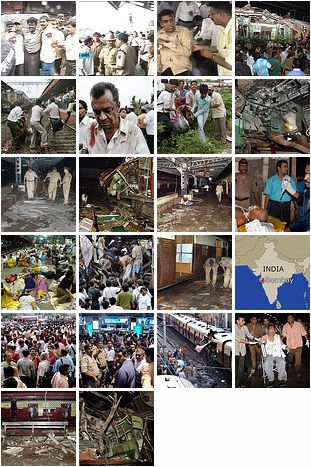
The truth is, from a literary perspective Khushwant Singh's novels really aren't that great. They aren't as adventurous as G.V. Desani's All About H. Hatterr, and not quite as carefully controlled as the novels written by his contemporaries in the 1950s -- i.e., R.K. Narayan. Train to Pakistan sold very well in the west, and was in print for years and years. As partition novels go, it isn't bad -- it's actually nicely plotted and suspenseful -- but it's just somewhat unremarkable. I Shall Not Hear the Nightingale and Delhi, by contrast, aren't especially readable.
After the 1950s, Khushwant Singh changed gears, and became more and more involved in journalism, which is where, I think, he's made his greatest contribution. For nine years, between 1969 and 1978, he was the editor of The Illustrated Weekly of India, an ancient institution that lasted for more than 100 years, and was, until the 1980s, the biggest English-language news-magazine in India (perhaps in all of Asia). Under the British, it was effectively a colonial society magazine, and it didn't change much under its first two Indian editors. Khushwant Singh was the third Indian editor, and he turned the ethos of the magazine on its head. He describes his approach in the preface to a collection of columns called Khushwant Singh's Editor's Page (1981):
Under its first two Indian editors [The Illustrated Weekly] became a vehicle of Indian culture devoting most of its pages to art, sculpture, classical dance and pretty pictures of flowers, birds, and dencing belles. It did not touch controversial subjects, was strictly apolitical and asexual (save occasional blurred reproductions of Khajuraho or Konarak). It earned a well-deserved reputation for dull respectability. I changed all that. What was a four-wheeled victoria taking well-draped ladies out to eat the Indian air I made a noisy rumbustious, jet-propelled vehicle of information, controversy and amusement. I tore up the unwritten norms of gentility, both visual and linguistic. . . . And slowly the circulation built up, till the Illustrated did become a weekly habit of the English-reading pseudo-elite of the country. It became the most widely read journal in Asia (barring Japan) because it reflected all the contending points of view on every conceivable subject: politics, economics, religion, and the arts.
I've spent some time looking at the magazine before, during, and after the Khushwant Singh years (1969-1978), and what he says above rings true. The earlier editors were very "respectable," with relatively safe short stories (often with a 'village' theme), and relatively bland features that mostly just synthesized the news. (In the 1960s, the magazine had a special section for "Women and Children," which says a lot about how it conceived of its readership.) Most English-speaking and reading middle-class Indians in the 1960s hadn't really remiagined themselves in a way that challenged the dominance of English norms. Given how limited the use of the English was at the time demographically, it's not hard to see how a continued dependence on England and Englishness could occur. (Several issues gave lavish coverage of Queen Elizabeth II's tour of India in 1967, for instance.)
Khushwant Singh has always written in English, and he was in every sense a contemporary of the "transitional" colonials: at the time of independence, he was already thirty-two, and had spent several years studying Law in Cambridge and at the Inner Temple, London. But as a journalist I think he broke the stranglehold of Anglophilia by taking the United States as his English-language reference point rather than England. As an editor, it was wild, sometimes trashy American culture in and after the 1960s that Khushwant brought into the pages of The Illustrated Weekly: rock n' roll, the Vietnam war protests, and the counter-culture (including the signficiant component of barefoot, Enlightenment-seeking hippies who ended up in India). Admittedly, some of the pictures of bikini-clad free-love kids in Goa splashed on the pages of The Illustrated Weekly were rather more like tabloid sensationalism than serious journalism, but there's no doubt that these images had an effect on how Indians saw themselves in that era.
I admire Khushwant Singh's secularism, which for me is always best represented by the Mario cartoon he used on his "Editor's Page" in The Illustrated Weekly: a caricature of himself, sitting next to a pile of books, a bottle of scotch, and a girlie magazine. This is the basis for the familiar Khushwant Singh slogan, "sex, scotch, and scholarship," which is also the title of one of his later books of essays. Much has been made of the "sex" and "scotch," both of which are somewhat ironic since testimony from people who've known him has confirmed that he's neither a womanizer nor a heavy drinker. "Sex, scotch, and scholarship" isn't literally Khushwant Singh's lifestyle (nor does it accurately represent his attitude towards women); it's rather a slogan for his fiercely independent ethos. It's something India still has need of: a willingness to publicly be something other than "respectable" and "respectful," to tell the truth rather than wrap the world in mysticism or one or another political ideology.
That's not to say that Khushwant Singh didn't make mistakes from time to time. His support for Indira Gandhi during the Emergency now looks extremely questionable, in that Christopher Hitchens-has-he-lost-his-mind? sort of way. And he probably should never have gotten involved with politics (though it could probably be argued that a Rajya Sabha seat isn't really a "political" post), though at least he knew when it was time (i.e., after 1984) to walk away.
The Sikh community has been somewhat ambivalent about Khushwant Singh over the years. Earlier, he was seen as too close to Indira Gandhi, despite his public rebuke of Operation Blue Star. During the years of militancy in Punjab, his strong opposition to the secesionist movement made things dangerous for him (I believe there was a price on his head for awhile). And even separate from these specific political questions, of course, Khushwant's aforementioned secularism -- his preference for scotch (Sikhs, remember, aren't supposed to drink alcohol), his crude humor, and his public declaration that he has no faith, have all eroded support for him from devout Sikhs. Despite that ambivalence, it's widely recognized that Khushwant Singh's History of the Sikhs is still a benchmark as a written introduction to the Sikh tradition. (Patwant Singh's recent book hasn't really caught on.) And he has, after all, retained the turban and beard that are so important to Sikh cultural identity. In short, despite everything, for most people, Khushwant Singh is still the same old Sardar.
To wrap up. In my view, Khushwant Singh's talent has lain not in deep or revolutionary thinking, but in the writing of his weekly columns and in a keen sense of what is timely, interesting, and important to talk about. He started doing this in the 1960s, and kept it up for thirty or more years, leaving a sizeable body of work. In a sense, this nurturing of the individualized, independent public voice is quite on par with what we bloggers ourselves do. Writing for The Illustrated Weekly or The Hindustan Times (which he took up in 1980), his voice perhaps had more authority than the average blogger's, but his consistent egalitarianism and irreverent tone gives me every reason to believe that Khushwant Singh would have a blog if he were fifty (or indeed, seventy) years younger. But who knows: the guy is still at it -- he might start one one of these days.
* * *
A final note. Khushwant Singh, at the age of 92, is still out and about. This summer he has been doing public lectures in Delhi on the history of the city (his father had a hand in the building of Edward Lutyens' New Delhi in the 1910s and 20s). He's also been publishing essays and books pretty regularly, though they aren't really of quite the same quality as some of his work from the 1970s.
[Cross-posted at Sepia Mutiny]
